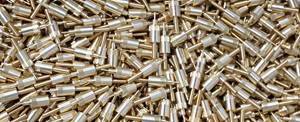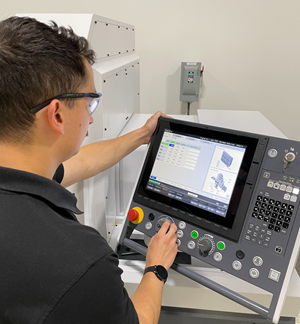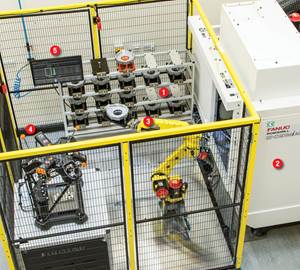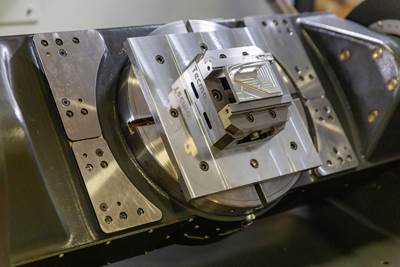Precision Shop Adopts Machine Monitoring, Boosts Revenue
Adopting machine monitoring helped LeClaire Manufacturing boost its vertical CNC utilization rates 38 percentage points and gain millions in revenue.
Share





Caddis Systems is a subsidiary of LeClaire Manufacturing. Development of the technology (such as the system’s physical component, the blue box seen in the image) has progressed to meet LeClaire’s specific machine monitoring needs, though the company also sells to other machine shops. Images courtesy of LeClaire Manufacturing.
Effective machine monitoring relies on gathering the right data points and presenting them in a usable format. After sampling several machine monitoring ecosystems and finding them overwhelming, LeClaire Manufacturing, an aluminum casting and precision component shop based in Bettendorf, Iowa, created its own: a streamlined device called Caddis and a subsidiary to develop it, Caddis Systems.
Even at this streamlined level, machine monitoring has improved LeClaire’s awareness of its utilization and spurred continuous improvement efforts. Its slight increases in machine numbers are joined by even larger increases in utilization and production hours, which have led to millions of dollars of additional revenue.
Taking Stock of the Big Picture
LeClaire Manufacturing has existed as a company since 1966, though its founders had ties to manufacturing going back to the 1890s. It offers a wide range of services from design and engineering to tool building, core making, real-time X-ray inspection, anodizing, machining and more. It also maintains a growing foundry business.
The company primarily works with aluminum alloys and some steel for tooling. It operates two shifts most days, but can flex into a third shift during high-demand periods across both its casting and machining departments. LeClaire operates 30 mills of three- and four-axis varieties from different manufacturers, as well as a mill-turn with live tooling capabilities. Caddis Systems also runs out of the same building as LeClaire’s tooling and machining departments.
All of which to say: LeClaire has a lot of variety in its machine shop, even with long-time contracts and repeat orders. Finding one machine monitoring platform that could handle all the business’s different facets and machines was a challenge, so the company decided to develop its own.

One of LeClaire’s desires for its machine monitoring system was that it would integrate with machines across a wide range of brands (it uses DN Solutions, Haas, Makino and Okuma machines, among others), and that it would be successful in both the machining and casting departments. Caddis has stabilized the casting department’s utilization rate, and improved utilization rates across both departments.
Focusing on the Essentials
The Caddis system combines a cloud-based software platform with a sealed device that the company says is rugged enough for both its machining and casting departments. The device uses stack light or direct wiring solutions to obtain data from machines, then uploads this data to the software platform through Wi-Fi, Ethernet or cellular connections.
LeClaire has set its Caddis devices to measure metrics like oil temperature and amperage in addition to traditional monitoring metrics such as machine uptime. The company then sets alarms to notify management if any metrics deviate from the baseline, giving its machine shop a chance to react before the deviation becomes an issue. Ralph Zimmerman, co-president of LeClaire Manufacturing, says that this has enabled staff to save motors from burning out, prevented metal freezing during power outages and preempted operational failures in its pumps, saving thousands of dollars of equipment and downtime.
Caddis’ software features user-customizable reports and dashboards, and can focus on data at the department, location and machine levels. In addition to the alarms, LeClaire credits much of its success with the Caddis system to its ability to track uptime and downtime, as well as its ability to attach reasons for downtime and the corrective actions the shop takes.
Better Systems Through Data
The years after LeClaire first debuted Caddis threw challenges at the shop, especially with a sizable contingent of experienced staff retiring at the onset of the COVID-19 pandemic. Caddis’ downtime tracking helped the shop overcome these challenges and improve its processes for the future. Zimmerman says that the software’s ability to identify inefficiencies was enough to reduce setup time on one job from 15 minutes to five, with the exactitude of the data building trust in the software.
This data has also helped build consistency into the shop’s CNC department. LeClaire plans for its machines to operate on a defined machining rate, and if the cycle time slows enough (or downtime extends long enough) to impact margins, the Caddis system triggers an alarm. Zimmerman says this has moved conversations about potential pain points in a process from after jobs are finished to while they are happening in real-time, better enabling the shopfloor staff to adjust processes.

At the start of LeClaire’s continuous improvement journey, its notification alarms for downtime only activated after 45 minutes of downtime. After several years of process overhauls and improvements, the shop has tightened the range of “standard” downtime to 10 minutes.
In particular, LeClaire has learned to compensate for the common causes of downtime on its machining centers. These compensations include the improvements to setup efficiency mentioned at the start of this section, as well as the introduction of regular preventative maintenance to minimize equipment downtime from wear and tear. The shop has also overhauled its planning and scheduling methods after finding that its previous methods were leading to quality issues and unstaffed, idle machines.
As a result, the shop significantly improved its utilization and profit margins. Between 2021 and 2023, the vertical machining department increased its utilization rate by 38 percentage points, even as it added two machines. During that same period, the horizontal machining department saw a 19-point utilization boost while adding four additional machines. Zimmerman estimates that this jump in utilization resulted into millions of dollars of revenue for LeClaire, and the continuous improvement habits the company adopted continue to provide benefits.
LeClaire credits these utilization changes — and the resulting profits — to the introduction of machine monitoring from its Caddis systems. An upfront accounting of the data the shop wanted was able to spur process improvements and kick-start a culture of continuous improvement, as well as save on replacement equipment. Zimmerman also says the realization of just how much productivity the company had yet to leverage on its existing machines has also saved it millions of dollars in capital equipment expenditures. Instead of chasing higher quantities of machines, the company has found success prioritizing and focusing on a smaller number of machines, much like how it has thrived with a focused approach to machine monitoring.
Related Content
Reinventing a Precision Shop With a Data-Driven Mindset
When this machine shop lost 90% of its business within three months, a reinvention was in order. Here's how it survived after quickly falling on hard times.
Read MoreManufacturer, Integrator, Software Developer: Wolfram Manufacturing is a Triple Threat
Wolfram Manufacturing showcased its new facility, which houses its machine shop along with space for its work as a provider of its own machine monitoring software and as an integrator for Caron Engineering.
Read MoreSwiss-Type Control Uses CNC Data to Improve Efficiency
Advanced controls for Swiss-type CNC lathes uses machine data to prevent tool collisions, saving setup time and scrap costs.
Read More5 Stages of a Closed-Loop CNC Machining Cell
Controlling variability in a closed-loop manufacturing process requires inspection data collected before, during and immediately after machining — and a means to act on that data in real time. Here’s one system that accomplishes this.
Read MoreRead Next
Machine Monitoring Spurs Shop's Meteoric Growth
EPTAM Precision Plastics has achieved multiple years of 15% YoY growth by effectively applying Datanomix’s benchmarking and machine monitoring features.
Read MoreCaddis Monitoring Device Increases Equipment Efficiency
IMTS 2024: CADDIS Systems is showcasing a real-time shopfloor monitoring device for temperature monitoring and improved OEE.
Read MoreDiving Deeper Into Machine Monitoring Data
Data visualization is the first step in using machine monitoring data, but taking it to the next level requires looking for trends within the data.
Read More





























